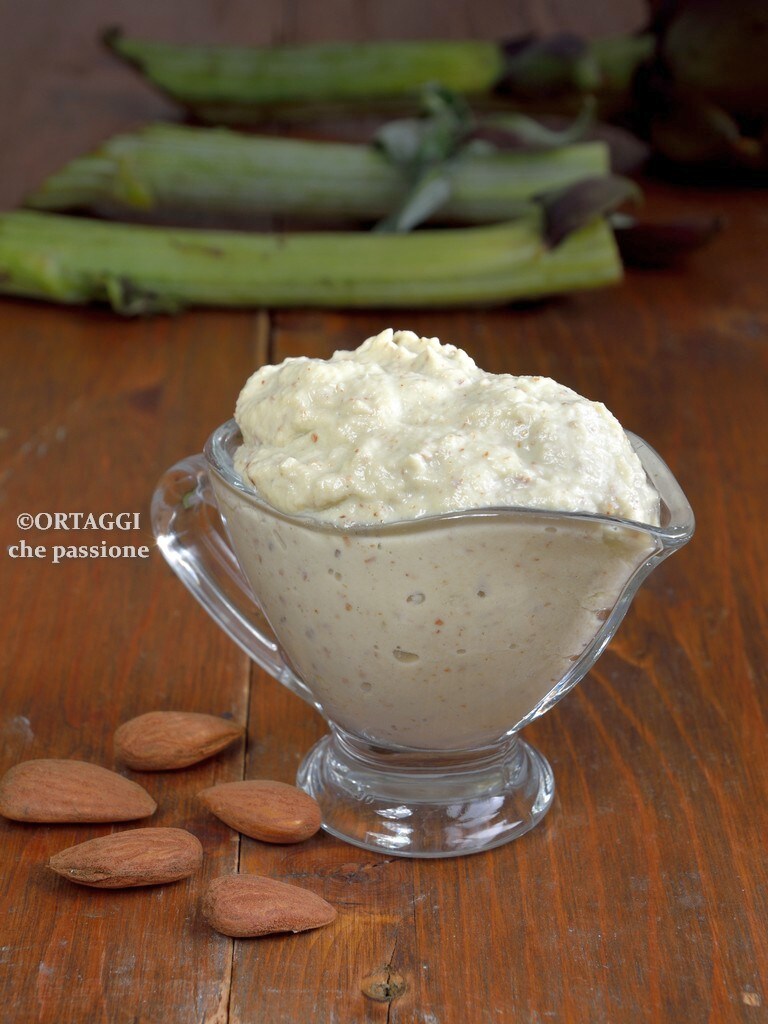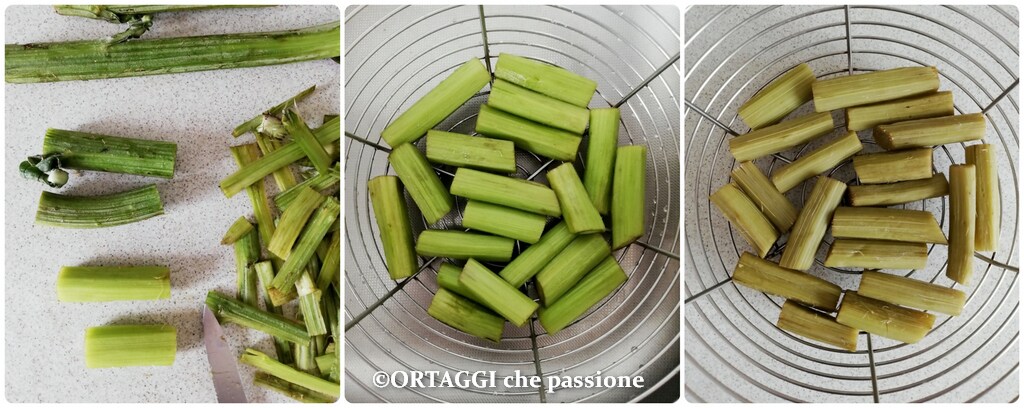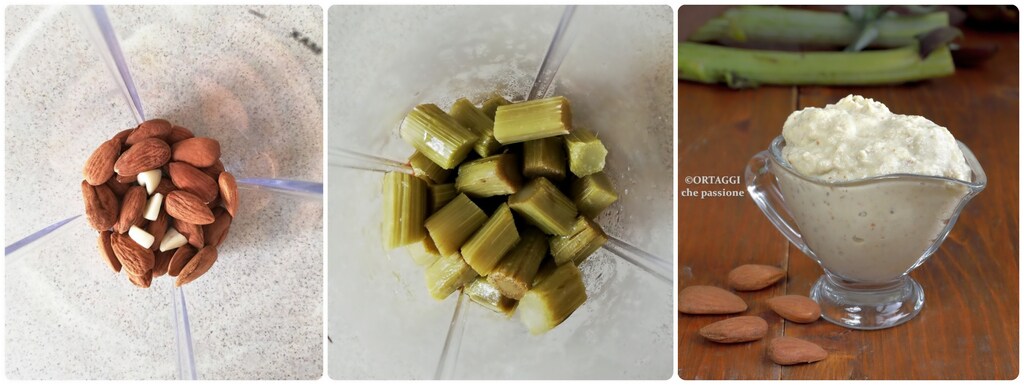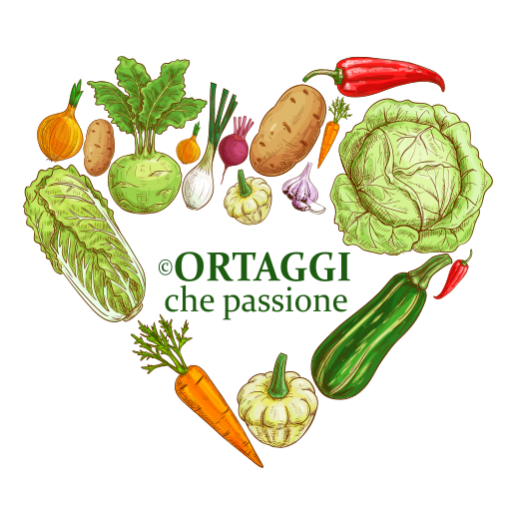Preparing a delicious artichoke pesto with a food processor (electric, Nutribullet, or Thermomix) is a creative way to make the most of this vegetable. This cream is an irresistible sauce for pasta, a fluffy mousse for bruschetta or canapés. For this pâté, you can use artichoke stems (as I did for a nowaste recipe), artichoke bottoms or opt for frozen artichoke hearts or artichokes in oil. Additionally, you can add your favorite nuts or seeds to enrich the flavor, or alternatively some lemon or orange juice for a smoother result.
SEASONALITY of the #artichoke – from October to May depending on the variety. If frozen, available all year round.
RECIPES with artichokes

- Difficulty: Easy
- Cost: Medium
- Preparation time: 15 Minutes
- Portions: 8
- Cooking methods: Stovetop, Steamed, Pressure Cooker
- Cuisine: Healthy
- Seasonality: Fall, Winter and Spring
- Energy 40.22 (Kcal)
- Carbohydrates 2.96 (g) of which sugars 0.32 (g)
- Proteins 1.21 (g)
- Fat 3.02 (g) of which saturated 0.33 (g)of which unsaturated 1.40 (g)
- Fibers 1.46 (g)
- Sodium 60.15 (mg)
Indicative values for a portion of 33 g processed in an automated way starting from the nutritional information available on the CREA* and FoodData Central** databases. It is not food and / or nutritional advice.
* CREATES Food and Nutrition Research Center: https://www.crea.gov.it/alimenti-e-nutrizione https://www.alimentinutrizione.it ** U.S. Department of Agriculture, Agricultural Research Service. FoodData Central, 2019. https://fdc.nal.usda.gov
Artichoke Pesto
- 5.3 oz artichokes (stems, bottoms, hearts or artichokes in oil – net weight)
- 0.88 oz almonds (or walnuts or oilseeds – optional)
- Half clove garlic (optional)
- 1 tbsp extra virgin olive oil
- to taste water (artichoke cooking water – about 1/4-1/3 cup)
- to taste salt
For a creamier sauce, use lemon juice and do not add nuts.
You can use various nuts like peanuts, hazelnuts, walnuts, pine nuts, pistachios, even mixed. Sunflower or pumpkin seeds are also excellent.
For a richer and less light pesto, replace part of the water with more extra virgin olive oil.
You can enrich this pesto with aromatic herbs like parsley, marjoram, mint, coriander, basil.
Tools
- Food Processor electric mixer
- Pressure Cooker
Artichoke Pesto
PREPARE THE ARTICHOKES (stems, bottoms, frozen hearts, or artichokes in oil)
Keep the cooking water to prepare and make the pesto more liquid.
🍀🍀🍀🍀
Cook the stems of the artichoke:
Cut the artichoke stems into regular pieces and then peel them to remove their more fibrous outer part, wash them. Then cook:
– steamed (for 30-40 minutes)
– in the pressure cooker (for 15 minutes from the classic whistle)
🍀🍀🍀🍀
Cook the bottoms of the artichoke:
– steamed (for 10 minutes)
– in the pressure cooker (for 4 minutes from the classic whistle)
🍀🍀🍀🍀
Cook the hearts of the artichoke:
– In the pan, pour the still frozen artichokes with a drizzle of oil and salt. Add a few tablespoons of water, cover, and cook for about 15 minutes, stirring as needed
– In boiling salted water, pour the still frozen artichoke hearts and cook them for 10 minutes from boiling
– In the microwave, place them in a suitable container with a little water, cover with the proper lid and cook at 750 watts for 5 minutes, then let them rest in the microwave for another 2 minutes.
🍀🍀🍀🍀
The artichokes in oil do not require cooking.

METHOD for artichoke pesto
With the FOOD PROCESSOR (as a paste)
Pour the almonds, garlic, and salt into the mixer bowl. Blend until it forms a powder, then add the cooked artichokes in pieces, the oil, and part of the cooking water (of the artichokes). Continue blending until the desired creaminess is achieved, adding more oil or water as needed according to your preferences.
With the NUTRIBULLET (as a mousse)
Pour into the 24 oz cup, in order: the pieces of cooked artichokes, garlic, almonds, coarse salt, oil, and the necessary cooking water (of the artichokes). Close the cup with the blade block, turn it, and lock it on the motor. Blend for 30-40 seconds, or until it forms a mousse.
With the THERMOMIX (as a cream)
Pour all the ingredients into the bowl. Blend for 20 seconds at speed 7. Add the oil and water and blend again for 20 seconds at speed 7.

STORING the artichoke pesto
To store artichoke pesto, transfer it to an airtight container and keep it in the refrigerator. Always close the container well after use and consume within 5 days of preparation.
To store artichoke sauce in the freezer, transfer it to suitable freezing containers. Be sure to eliminate air inside the container to prevent ice formation. The pesto can be stored in the freezer for several months, generally up to 3 months. To use, defrost in the refrigerator overnight and mix well before serving.
SURPRISING TWISTS
vegans
Enrich the pâté with parsley, marjoram, mint, coriander, basil, or celery.
Spread on a slice of whole wheat bread and top with sun-dried tomatoes, mushrooms, or artichokes in oil.
Create an appetizer glass: a layer of artichoke mousse, one of boiled Roman cauliflower or broccoli florets, and some chia seeds (or black sesame seeds).
Spread on a slice of black bread and enrich with pomegranate seeds and chopped walnut kernels.
vegetarians
Enrich with ricotta, spreadable cheese, cream, or grated cheese.
Serve on a crostini with cheese flakes.
On toasted slices, spread artichoke sauce and top with slices of hard-boiled eggs.
artichoke pesto with fish
Chop with some anchovy or sardine fillets.
Pair this artichoke mousse with canned tuna or mackerel or smoked salmon or trout.
Spread the sauce on a baguette slice and enrich with some cooked shrimp.
artichoke pesto with meat
Enrich and chop with diced cooked ham or mortadella.
Spread on a crostoni (flatbread, pinsa romana or focaccia) and enrich with slices of salami, prosciutto, speck, pancetta, or crispy guanciale.
Use as a gourmet side dish for roast, boiled meats, or other meat mains.
FAQ (Frequently Asked Questions)
What does the artichoke stem contain?
The artichoke stem contains fibers, water, and other nutrients. It is an edible part of the artichoke and can be cooked in various ways, such as boiled, pan-fried, grilled, or added to soups, omelets, and stews. The stem is tasty and adds an interesting texture to dishes. Before cooking, it is necessary to remove the more fibrous outer part of the stem.
What is the edible part of the artichoke?
The artichoke is a vegetable whose main edible part is the heart, located at the center of the inflorescence. The inflorescences are harvested while the buds are still immature and before the purple flowers bloom. Besides the heart, the more tender and fleshy outer leaves can be eaten, after cooking, the tip of these leaves is scraped off with teeth or the side of a fork. The artichoke stem is also edible and before cooking it, the more fibrous outer part should be removed.
What to do with artichoke cooking water?
Artichoke cooking water can be reused in cooking. You can use it to prepare broths, soups, cook rice or pasta, create sauces or bagna cauda, or even as a healthy drink. If not used in cooking, it can be employed as a fertilizer for plants.

